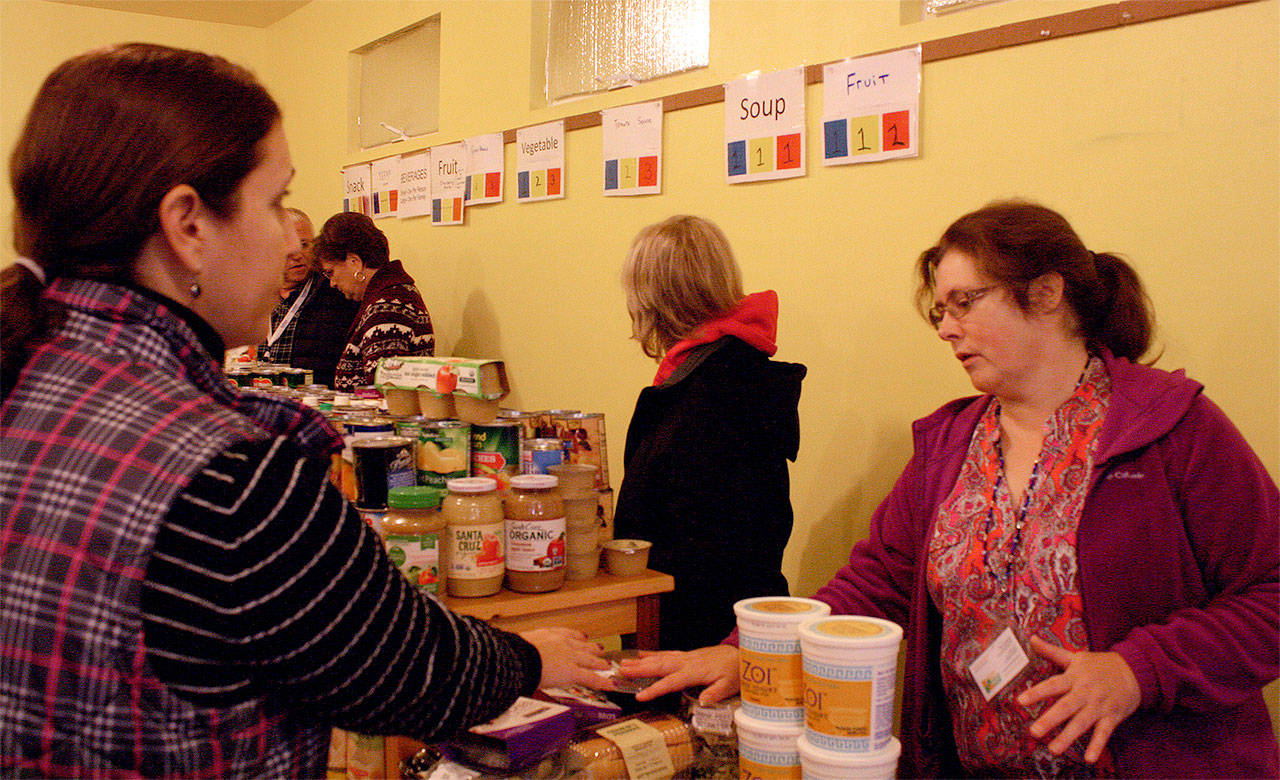By Hannah Pickering
Contributing Writer
Directly across from the North Bend Community Church you’ll find the Snoqualmie Valley Food Bank. Small enough that one could reach out their hands and almost touch each wall, the space is more than a building.
Within the span of a visit, the office transforms into a hub of activity, resources and partnership for residents of the Snoqualmie Valley.
“It’s so important to reach people where they are at,” said Snoqualmie Valley Food Bank Executive Director Heidi Dukich, as she walked through the office, out the screen door and beneath the porch eaves.
By early afternoon, the produce section at the food bank had already been picked over, sending half of the food home to pantries. The air was saturated with the earthy scent of fresh vegetables.
Perched on stools located behind the meat and dairy table, two volunteers smiled and greeted clients warmly, offering help as needed and making sure that the table stayed well stocked.
Clients entering through the front entrance signed into a register, and were given a colored clothespin. A blue pin indicated that the client was the sole member of a household, a yellow, that they were from a household of two to four people and a red pin for households of at least five people.
While SVFB has grown over the years – now employing five people fulltime — many of the community members involved in the food bank are volunteers.
Scrolling through a long list of volunteers on a computer perched next to a hefty scale, Dukich said that the food bank is supported by around 200 people.
Some of these volunteers are high school students completing their mandatory volunteer hours, Director Nancy Jones said. And most of them live in the Valley.
The spirit of connection and the emphasis on community that is bringing together local Valley residents is part of the food bank’s goal to create a welcoming and empowering culture.
Clients vary in age, background and needs, and the food bank has partnered with organizations like Eastside Baby Corner in Issaquah to ensure that local residents are having their needs meet, whatever they might be.
Clients who are experiencing food insecurity don’t fit a stereotype, Dukich said. Not everyone who is food insecure in the community is homeless.
Hunger can be a symptom of a variety of life circumstances that lead to food insecurities, including job loss, struggling to age on slim Social Security checks, an accident, a disability or rising housing costs.
The Snoqualmie Valley is far enough from Seattle that it loses its association with the metropolitan city’s exorbitant housing market. But the community, usually perceived as a haven for outdoor enthusiasts and hikers, is also home to food insecurity and rising housing costs.
The U.S. Department of Health found that around 14 percent of Washington residents were food insecure for the years 2011 to 2013. The effects of this food insecurity are varied, impacting health and the academic performance of children. Food insecurity is also associated with psychosocial problems and impaired cognitive functions, according to Washington state’s DOH.
Once housing costs represent over 30 percent of a family’s household budget, it is no longer affordable, according to the Department of Housing and Urban Development. But by 2012, HUD had estimated that 33 percent of Washington residents were spending over the 30 percent.
The data highlights the reality that food insecurity is much closer to home, as opposed to the common perception of hunger.
“It’s hard to get the message across of who is hungry,” Dukich said. “Hunger is your neighbor.”
And the impact is greater when it is made in partnership with the community. SVFB works with local organizations like Eastside Baby Corner, Northwest Harvest, Food Lifeline and The Emergency Assistance Program, ensuring that instead of creating just another nonprofit, Snoqualmie Valley Food Bank is responding to community needs by linking people with available services.
Several resource boards were tacked to the street facing exterior of the food bank, containing information on job postings, housing and upcoming events.
That’s why 60 percent of the food coming into the food bank is from local groceries like the Safeway stores in North Bend and Snoqualmie Ridge and the Ridge Supermarket IGA. The bank, Dukich said, receives around 30,000 to 50,000 pounds of groceries on a weekly basis from local grocery resource partners.
Volunteer drivers hop in the refrigerated van that the food bank recently purchased with grant funds, and go from store to store picking up food set aside for the organization.
But addressing food insecurity in the valley doesn’t end at providing food resources. Hunger can also include a gap in knowledge of how to prepare balanced, nutritious meals. The Snoqualmie Valley Food Bank addresses this need by providing nutrition education to their clients, as well as recipes for healthy meals.
The food bank is also the recipient of funding from the city of North Bend as part of its human and community services.
The city of North Bend doesn’t have a department that specifically responds to food insecurity in the community, council member Trevor Kostanich said.
“Until we have a lot bigger city…we don’t have a lot of personnel,” Kostanich said, noting that the food bank has a phenomenal group of volunteers.
The food bank is serving as the access point that brings together the resources and services of various community organizations.
“We utilize our resources with the intention of making the greatest impact,” Dukich said.


